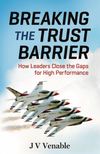Thunderbirds Commander’s New Book Is More Of What We Already Know
I recently had the pleasure of reading “Breaking the Trust Barrier: How Leaders Close the Gaps for High Performance” by...

I recently had the pleasure of reading “Breaking the Trust Barrier: How Leaders Close the Gaps for High Performance” by retired Air Force Col. JV Venable, who formerly commanded the Thunderbirds, the Air Force’s crack flight demonstration squadron. His new book is a quick and easy read focusing on success found through a repeatable formula that Venable has used through multiple commands. It reinforces concepts anyone who has led an organization should know. That said, it’s not always easy to focus on these concepts on a daily basis, but Venable seems to have cracked the code and aims to share it with all of us through his book.
That is the main point of Venable’s new book: Get to know your people, provide guidance and vision but not dictatorship, and all parties will succeed more than they would on their own.
Related: Want To Build An Effective Team? Check Your Ego At The Door »
Specifically, Venable focuses on the concept of drafting. The technique where two vehicles or other moving objects align in a close group reducing the overall effect of drag due to exploiting the lead object's slipstream. When high speeds are involved, drafting can significantly reduce the average energy expenditure required to maintain a certain speed and can also slightly reduce the energy expenditure of the lead vehicle or object. Venable argues that in business or any other organization, the concept of drafting can be applied to people and work processes. If the team is operating closely together and in sync, the drag will be reduced and efficiency will increase, thereby increasing productivity.
The concepts are easy enough to follow, and as with many of these types of books, execution is everything. Closing the gaps is important. Working together as a well-oiled machine is important. And painting all of these concepts against the backdrop of the Thunderbirds makes this a more interesting read.

“Breaking the Trust Barrier” addresses the idea of success through gaining trust in three specific areas: commitment, loyalty, and trust. Venable argues that the steps are quite linear and one must establish each of these before the next can begin. I tend to agree with nearly everything he says in this book, and really enjoyed the specificity with which he addresses each potential gap closure opportunity. His stories are compelling and the progression makes worlds of sense.
However, none of this seems like new information.
It feels a bit self-serving, but that’s fair. As a Navy veteran, I much prefer the leadership books produced by Navy veterans. Many of what Venable covers can be gleaned from any military (or civilian) leadership course. I think that stories from other folks, in their own words, would’ve added a great deal to the book.
One of my favorite parts about this book are the analogies, which are fabulous and appropriate. By the end, however, it gets a bit tiring hearing about how awesome the Thunderbirds are.
There is no shortage of books on leadership from former military leaders. The message that Venable sends in his book — build and keep trust — seems easy, but anyone who’s worked in a complex organization knows how tough it is. That said, there is nothing that really sets the book apart from any other mid-level officer’s viewpoint. The audience who will love this one in particular are airmen, Air Force veterans, and aviation enthusiasts.
All in all, “Breaking the Trust Barrier” is a good but familiar read. I doubt it will change anyone’s life, but imagine it will reinforce concepts not at all foreign to readers. I would recommend it to anyone looking to brush up on some repeatable leadership techniques.
“Breaking the Trust Barrier: How Leaders Close the Gaps for High Performance” (Berrett-Koehler Publishers, 2016) is available for purchase now.